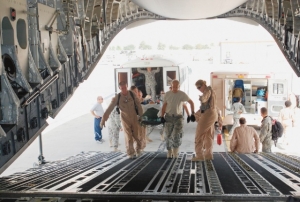Care in the sky: Members of the aeromedical evacuation crew fight to get injured troops back to their families
By Kenneth Fine
Published in News on July 6, 2009 2:10 PM

Kenneth Fine
Members of the 455th Expeditionary Aeromedical Evacuation flight at Bagram Air Base, Afghanistan, load patients onto a Mississippi Air National Guard C-17 III Globemaster.
EDITOR'S NOTE: The patients on this medical evacuation flight requested that we not photograph their faces -- and the only one who agreed to talk about his injuries asked that his name not be used. We respected their wishes.
THE SKIES BETWEEN AFGHANISTAN AND GERMANY -- The cost of freedom was on display July 4 at Bagram Air Base, Afghanistan, as more than a dozen wounded Coalition troops were loaded onto a Mississippi Air National Guard C-17 III Globemaster bound for Ramstein Air Force Base, Germany.
The patients were supposed to be transported via a 916th Air Refueling Wing KC-135R Stratotanker.
But when severe weather forced the cancellation of its mission, Air Mobility Command officials rerouted the Jackson-based aircraft to ensure those men and women made it to topnotch medical care as quickly as possible.
During the Vietnam War, it might have taken as many as 45 days to get those injured in combat to the kind of care they now get within 72 hours of their injury.
And for Capt. Rob Grones, one of the pilots aboard that flight, being a part of that effort touches his heart.
"Any aeromedical evacuation mission is pretty rewarding -- but especially today, on the 4th of July," he said. "I mean, these guys are out there putting their lives on the line. So, it's pretty tough to see sometimes, but it's all for a good cause."
A chaplain from Fort Bragg, N.C., was among those in need of care.
His knee was in "pretty bad shape," said Capt. Christine Jones, a member of the 455th Expeditionary Aeromedical Evacuation Flight who accompanied the patients from Bagram to Germany.
But he wasn't thinking about the pain as that C-17 made its way from the desert to the Free World.
He was thinking about those he left behind on the front lines.
"I guess the hardest thing is having to leave my troops. I'm pretty disappointed," the chaplain said, choking up. "It's possible I could end up going home, but even if I do, I'm hoping I'll be able to come back to finish the tour."
Some of the other patients on that flight were in worse shape -- suffering from gunshot wounds and injuries associated with Improvised Explosive Device blasts.
Ms. Jones feels their pain during every mission she is a part of.
"Sometimes it's pretty heartbreaking," she said. "I mean, you've got guys with both their legs blown off and you're just trying to keep them stabilized long enough to get them to Germany alive."
Evacuation crews are successful in that mission more than 90 percent of the time, officials said.
Yet, "most people don't know this exists -- that you can do this in an airplane," Ms. Jones said.
Medical teams are able to provide care for the duration of the long flight to Germany thanks to the transformation that takes place hours before the aircraft takes off from Bagram.
By the time airmen are done loading the equipment on board, the inside of the plane -- whether a Strato-tanker or Globemaster -- resembles a fully-functioning Emergency Room, complete with advanced life support equipment, medication, cardiac drugs, ventilators, oxygen tanks, bandages and more.
That young chaplain appreciates the warmth of the medics who stood by his side during the flight.
But he would much rather have been back in the desert fighting, so that one day, Afghans, too, would have an Independence Day.
"I just felt like it was the right thing to do. I just wanted to serve my country -- serve my family," he said. "Now, who knows? I hope I can go back, but they haven't told me yet.
"They need me out there. I have guys who need me," he added, choking up again before laying his head back onto the pillow placed there by one of the medics shortly after takeoff. "This isn't the way it's supposed to be. I'm supposed to be with my men."
After landing at Ramstein, the aircraft was met by another medical team, members of the 435th Aerospace Medicine Squadron.
And within days, they will be on their way to the Landstuhl Medical Center, an American military hospital located just out the Ramstein gates -- and then, likely, back home to recover among family.
Just don't tell that chaplain he probably won't go back to the desert.
"I have to," he said. "I just have to."
